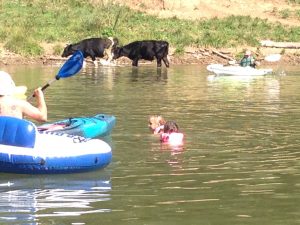
In Part Because of Livestock Industry Pollution, 83 Percent of Sampling Places Exceed Safe Standards for Swimming and Water Contact in 2017-2018
Washington, D.C. – As Labor Day Weekend approaches and families plan to raft and tube in the Shenandoah River, a new analysis of state water monitoring data shows bacteria levels above safe levels for water contact at about 83 percent of 48 monitoring locations.
“This is an indication that Virginia still isn’t doing enough to control manure runoff pollution from the growing livestock industry in the Shenandoah Valley and to help farmers fence cattle out of streams,” said Eric Schaeffer, Executive Director of the Environmental Integrity Project (EIP).
In a previous analysis of state monitoring data released in April 2017, EIP found that 43 (90 percent) of 48 sampling locations in the Shenandoah River basin were unsafe for swimming or other water contact recreation between 2014 and 2016.
This most recent analysis checked if E. coli levels at those locations had changed over the past year and a half (from January 2017 through June 2018), and results were similar, if slightly lower. Forty of the 48 locations (83 percent) were unsafe for water contact, according to Virginia’s standards.
Virginia advises avoiding swimming or water contact recreation in freshwater that exceeds 235 colony forming units (CFU) of E. coli per 100 mL of water more than 10 percent of the time, because the bacteria is often an indicator of fecal pathogens that can cause stomach and intestinal illnesses in children and adults who accidentally swallow water.
In the Shenandoah River basin, animal manure is the major source of E. coli bacteria either from cattle wandering directly into rivers and streams or manure being spread onto crops and pastures as fertilizer, which runs off into waterways, according to a 2017 Environmental Integrity Project report, “Water Pollution from Livestock in the Shenandoah Valley.” Other sources, including wildlife, urban runoff, and sewage plant effluent, also contribute to the problem.
EIP’s report recommended that Virginia take several steps to reduce agricultural pollution in the Shenandoah, including establishing a better system for collecting and disposing of surplus livestock manure; requiring fertilizer management plans for all farms that spread manure; increasing inspections and enforcement; and requiring all farmers to fence their cattle out of public waterways.
In EIP’s 2018 follow up examination of state bacteria data in Shenandoah waterways, the organization found that E coli level improved at four of the 48 water quality monitoring sites between 2014-2016 and 2017-2018, while they worsened at one location.
For an online map with data at each of the locations, click here.
The four that improved recently were Cedar Creek near Marlboro in Frederick County; the North Fork near Mt. Jackson; the North Fork near Riverton; and the South River near Grottoes. All of these locations exceeded the recreational standard between 2014 and 2016, but did not exceed the standard between January 2017 and June 2018.
Only one of the 48 sites appears to have worsened between the 2014-2016 and 2017-2018 sampling periods. That was along the South Fork of the Shenandoah River downstream of Waynesboro. Here, 5 of 17 samples have exceeded the E. coli standard since January 2017. There were no transgressions of state health standards at that spot between 2014 and 2016.
Sampling results from June 2018 show that the very highest E. coli levels at the 48 sites were at two sampling locations along Linville Creek in Rockingham County between the towns of Edom and Broadway, where concentrations ranged from 6,131 CFU/100mL (26 times the numeric state standard for bacteria concentrations) to higher than 24,196 CFU/100mL (103 times the standard).
In total, the Virginia Department of Environmental Quality sampled 85 locations along Shenandoah Basin waterways between January 2017 and 2018. But 37 of those locations were not included in EIP’s 2017 study because they were not sampled between 2014 and the end of 2016.
Of the 37 “new” locations added since the end of 2016, 22 (59 percent) exceeded health standard for water contact recreation. Two newly-sampled hot spots are near McGaheysville, Virignia, along both South Fork, where the state in June 2018 measured bacteria concentrations of 24,196 CFU/100mL, and Cub run, where concentrations hit 17,329 CFU/100mL.
“While health warnings for the public are important, the bigger picture is that the Shenandoah watershed should be treated as more than just a drainage system for the livestock industry,” said Schaeffer of EIP, former Director of Civil Enforcement at EPA. “With more effective controls on agricultural pollution, Virginia can keep its waterways clean enough for all citizens to enjoy.”
See our online map for more detailed information on bacteria levels at each location in the Shenandoah river system.
Media contact: Tom Pelton, Environmental Integrity Project, tpelton@environmentalintegrity.org or (443) 510-2574.
The Environmental Integrity Project is a nonprofit, nonpartisan organization that empowers communities and protects public health and the environment by investigating polluters, holding them accountable under the law, and strengthening public policy.
###


